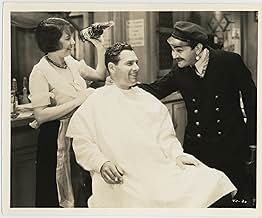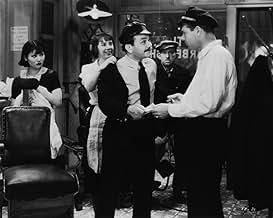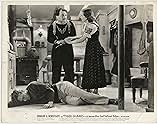IMDb रेटिंग
6.3/10
1.2 हज़ार
आपकी रेटिंग
अपनी भाषा में प्लॉट जोड़ेंA tuna fisherman marries a woman who doesn't love him.A tuna fisherman marries a woman who doesn't love him.A tuna fisherman marries a woman who doesn't love him.
- पुरस्कार
- कुल 2 जीत
J. Carrol Naish
- Tony
- (as J. Carroll Naish)
Maurice Black
- Jean Fernandez - a Shipwrecked Crewman
- (बिना क्रेडिट के)
Sheila Bromley
- 'Red'
- (बिना क्रेडिट के)
Wong Chung
- Chinese Laundryman
- (बिना क्रेडिट के)
Edwin Maxwell
- Doctor
- (बिना क्रेडिट के)
Toshia Mori
- Oriental Lady Barber
- (बिना क्रेडिट के)
Henry Otho
- Crewman
- (बिना क्रेडिट के)
Inez Palange
- Mike's Neighbor
- (बिना क्रेडिट के)
Pedro Regas
- Crewman
- (बिना क्रेडिट के)
Joe Roig
- Undetermined Secondary Role
- (बिना क्रेडिट के)
Hector V. Sarno
- Crewman
- (बिना क्रेडिट के)
Harry Semels
- Crewman
- (बिना क्रेडिट के)
फ़ीचर्ड समीक्षाएं
Portuguese fisherman (Edward G. Robinson) loses a hand to a shark and later loses his young wife (Zita Johann) to his best friend (Richard Arlen). He doesn't like it. A simple plot that was reused by Warner Bros. many times over the years. It's an okay early film from Howard Hawks. Worth watching for Robinson's colorful performance. Eddie G's sporting an earring and a hook for a hand, folks. It's not Shakespeare but it's hard to look away. Real maritime footage is a plus. Classic horror fans will recognize Zita Johann from The Mummy, which was released this same year. She's a lot more subtle in this than in that film.
Exciting film about a love triangle on the Monterey coast with Edward G. Robinson and Richard Arlen best friends and tuna fishermen. Robinson falls for bad girl Zita Johann who of course falls for handsome Arlen. Familiar storyline but Robinson is excellent as the Portuguese fisherman who battles the sea and the sharks to make a living. Arlen was a so-so actor but very handsome, and Johann had a strange exotic look. She's best remembered for The Mummy with Boris Karloff. Vince Barnett is funny and J. Carroll Naish has one scene. Leila Bennett plays a barber for some reason with pretty Toshio Mori as her assistant. Inez Palange plays a neighbor. Good film all around. But the highpoint is the truly remarkable footage of tuna fishing in a stormy sea.
Sorry, I forgot to add a point to my comment that was rather an important one, at least to me. Tiger Shark was shot in the early 1930s and there are some interesting scenes of men sailing their boat into a school of tuna, guided by a lookout, then lining up in the leads and pulling the fish in using flexible poles, one at a time. The scenes are authentic and exciting. Alas, they are history. Tuna fisherman now use "long lines." (Koreans and Japanese have huge industries built around this technique.) The fishing boat now needs a smaller crew (less expensive) because there no longer any mano a mano contests between fish and man. The crew simply strings out long fishing lines, guided by sonar, more than a mile long, with baited hooks fixed to the lines at short, regular intervals, set for a given depth. This has proved far more lucrative than fishing exclusively for tuna with poles. The long lines have a tendency to clean everything that swims out of the sea; not just tuna but sharks, sea turtles, porpoises, and game fish like marlin (which can't be legally sold). By the time they are harvested, many of the animals are already dead, especially the air-breathing turtles and porpoises. The industry has become much more efficient and without passion. Mike probably wouldn't have approved but the organization that would now own his boat would have.
I had once taped this one off Italian TV (during a lengthy Howard Hawks season of films shown in English but with Italian subtitles) but my VCR developed a fault and the recording was subsequently unwatchable! I sure am glad to have caught up with it now
First of all, Edward G. Robinson is the whole show here: his portrayal of the central character, a Portuguese fisherman who sees himself as the best in the business and speaks in amiable broken English (his catchphrase is: "Absolutely indeed") is first-rate and it was also quite funny to watch him sporting an earring. The plot is predictable enough (a woman comes between two best friends and the situation is resolved through tragedy) but that may be because the same elements were recycled so many times, even by Warner Bros. themselves, over the years: SLIM (1937), THE WAGONS ROLL AT NIGHT (1941), Raoul Walsh's MANPOWER (1941; with Marlene Dietrich coming between Edward G. Robinson and George Raft), etc.
Even more importantly, however, the imprint of director Howard Hawks is all over it: the vivid recreation of a man's world, the bonds which grow stronger through the everyday adversity which that entails, the invasion of a woman into this enclosed world which sets about the inevitable tragedy, etc. In fact, the brotherly (or even father-son) relationship seen here between Robinson and his younger protégée, Richard Arlen, is reprised in many another Hawks film Pat O'Brien and James Cagney in CEILING ZERO (1935), Thomas Mitchell and Cary Grant in ONLY ANGELS HAVE WINGS (1939), Walter Brennan and Humphrey Bogart in TO HAVE AND HAVE NOT (1944), John Wayne and Dean Martin in RIO BRAVO (1959), etc; the unceremonious intrusion of the female character onto a perfectly ordered way of life is also seen enacted by Katharine Hepburn in BRINGING UP BABY (1938), Jean Arthur in ONLY ANGELS HAVE WINGS, Barbara Stanwyck in BALL OF FIRE (1941), Lauren Bacall in TO HAVE AND HAVE NOT, Joanne Dru in RED RIVER (1948), Margaret Sheridan in THE THING FROM ANOTHER WORLD (1951), Angie Dickinson in RIO BRAVO, Elsa Martinelli in HATARI! (1962) and Paula Prentiss in MAN'S FAVORITE SPORT? (1964); early on, the "boys" in TIGER SHARK are gathered around drinking and singing to their hearts' content a similar instance occurs also in ONLY ANGELS HAVE WINGS, RIO BRAVO and HATARI! Besides Robinson's performance and the fascinating early look at the Hawksian themes elaborated on more fully in his later films, TIGER SHARK is also notable for its exciting fishing sequences especially the rather grisly (for their time) shark attacks; the scene where Robinson loses his hand to one of the marauding beasts is particularly effective.
Actually, this viewing of TIGER SHARK has reminded me of several notable films which Robinson appeared in around the same time but with which I'm not all that familiar having watched them only once years ago, namely TWO SECONDS (1932), THE MAN WITH TWO FACES (1934), John Ford's THE WHOLE TOWN'S TALIKING (1935), Hawks' own BARBARY COAST (1935), THE LAST GANGSTER (1937), A SLIGHT CASE OF MURDER (1938), THE AMAZING DR. CLITTERHOUSE (1938), CONFESSIONS OF A NAZI SPY (1939), THE SEA WOLF (1941) and MANPOWER!
Even more importantly, however, the imprint of director Howard Hawks is all over it: the vivid recreation of a man's world, the bonds which grow stronger through the everyday adversity which that entails, the invasion of a woman into this enclosed world which sets about the inevitable tragedy, etc. In fact, the brotherly (or even father-son) relationship seen here between Robinson and his younger protégée, Richard Arlen, is reprised in many another Hawks film Pat O'Brien and James Cagney in CEILING ZERO (1935), Thomas Mitchell and Cary Grant in ONLY ANGELS HAVE WINGS (1939), Walter Brennan and Humphrey Bogart in TO HAVE AND HAVE NOT (1944), John Wayne and Dean Martin in RIO BRAVO (1959), etc; the unceremonious intrusion of the female character onto a perfectly ordered way of life is also seen enacted by Katharine Hepburn in BRINGING UP BABY (1938), Jean Arthur in ONLY ANGELS HAVE WINGS, Barbara Stanwyck in BALL OF FIRE (1941), Lauren Bacall in TO HAVE AND HAVE NOT, Joanne Dru in RED RIVER (1948), Margaret Sheridan in THE THING FROM ANOTHER WORLD (1951), Angie Dickinson in RIO BRAVO, Elsa Martinelli in HATARI! (1962) and Paula Prentiss in MAN'S FAVORITE SPORT? (1964); early on, the "boys" in TIGER SHARK are gathered around drinking and singing to their hearts' content a similar instance occurs also in ONLY ANGELS HAVE WINGS, RIO BRAVO and HATARI! Besides Robinson's performance and the fascinating early look at the Hawksian themes elaborated on more fully in his later films, TIGER SHARK is also notable for its exciting fishing sequences especially the rather grisly (for their time) shark attacks; the scene where Robinson loses his hand to one of the marauding beasts is particularly effective.
Actually, this viewing of TIGER SHARK has reminded me of several notable films which Robinson appeared in around the same time but with which I'm not all that familiar having watched them only once years ago, namely TWO SECONDS (1932), THE MAN WITH TWO FACES (1934), John Ford's THE WHOLE TOWN'S TALIKING (1935), Hawks' own BARBARY COAST (1935), THE LAST GANGSTER (1937), A SLIGHT CASE OF MURDER (1938), THE AMAZING DR. CLITTERHOUSE (1938), CONFESSIONS OF A NAZI SPY (1939), THE SEA WOLF (1941) and MANPOWER!
Edward G. Robinson plays a one handed fisherman making his living on the California coast. Even with a hook for a left hand he does pretty good in his line of work. But that steel hook isn't exactly quail bait.
One of his crew is lost to the sharks during a voyage and he brings the news home to his daughter Zita Johann. She's back home after having run away from the fishing life and has had a pretty rough go of it.
Though she doesn't love him, Johann marries Robinson and then another Robinson's crew, Richard Arlen comes in to complicate things.
Other reviewers have mentioned the gazillion times Warner Brothers recycled the plot of Tiger Shark in other locales. But actually Robinson had done a version of They Knew What They Wanted back in 1930 entitled A Lady to Love. That's the real origin of this plot.
The fishing boat scenes are realistically handled and the principal players do a good job. But this story has been told better and told better by Mr. Robinson himself.
One of his crew is lost to the sharks during a voyage and he brings the news home to his daughter Zita Johann. She's back home after having run away from the fishing life and has had a pretty rough go of it.
Though she doesn't love him, Johann marries Robinson and then another Robinson's crew, Richard Arlen comes in to complicate things.
Other reviewers have mentioned the gazillion times Warner Brothers recycled the plot of Tiger Shark in other locales. But actually Robinson had done a version of They Knew What They Wanted back in 1930 entitled A Lady to Love. That's the real origin of this plot.
The fishing boat scenes are realistically handled and the principal players do a good job. But this story has been told better and told better by Mr. Robinson himself.
क्या आपको पता है
- ट्रिवियाQuita wears traditional Portuguese attire for her wedding.
- गूफ़When Quita tells Mike to leave her alone after being informed of her father's death, he responds twice with "yeah, all right". But Robinson as Mike drops the Portuguese accent he uses for the role and uses a regular American accent.
- क्रेज़ी क्रेडिटOpening Card: San Diego
- कनेक्शनFeatured in Sharksploitation (2023)
- साउंडट्रैकAbdulla Bulbul Amir
(1877) (uncredited)
Written by William Percy French
Sung by Richard Arlen and members of the crew
टॉप पसंद
रेटिंग देने के लिए साइन-इन करें और वैयक्तिकृत सुझावों के लिए वॉचलिस्ट करें
विवरण
- चलने की अवधि1 घंटा 17 मिनट
- रंग
- ध्वनि मिश्रण
- पक्ष अनुपात
- 1.37 : 1
इस पेज में योगदान दें
किसी बदलाव का सुझाव दें या अनुपलब्ध कॉन्टेंट जोड़ें





































